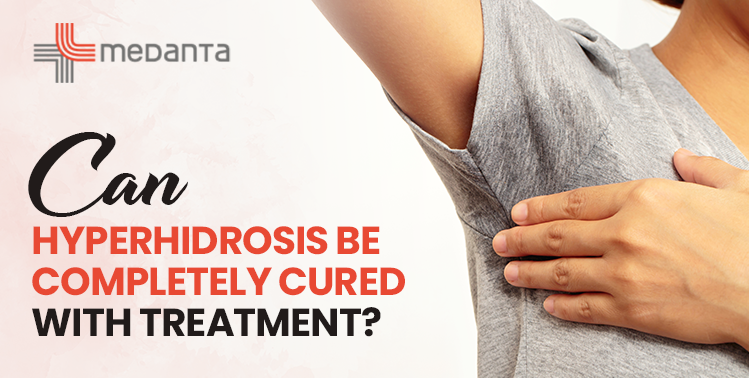CH Baktawar Singh Rd, Medicity, Islampur Colony, Sector 38, Gurugram, Haryana 122001

28 July, 2025
adminHave you ever found yourself sweating too much — even when you’re not hot, exercising, or nervous? If so, you might be dealing with hyperhidrosis, a condition that causes excessive sweating beyond what’s normal or necessary for the body to cool itself.
Hyperhidrosis can affect daily life, self-confidence, and even social interactions. You might avoid shaking hands, wearing light-colored clothes, or participating in physical activities for fear of embarrassing sweat stains. But a question many people ask is: Can hyperhidrosis be completely cured with treatment?
The short answer is: It depends. Some treatments can offer long-term relief, but whether it’s a full “cure” depends on the type of hyperhidrosis and the chosen treatment. In this blog, we’ll explore what hyperhidrosis is, the types, available treatments, and whether a permanent cure is possible.
Hyperhidrosis is a condition where the body sweats much more than it needs to regulate temperature. This excessive sweating usually affects certain parts of the body like:
In more severe cases, it can occur all over the body (called generalized hyperhidrosis).
Sweating is natural, it’s the body’s way of cooling down. But in people with hyperhidrosis, the sweat glands overreact, producing sweat even when it’s not needed.
Understanding the type of hyperhidrosis you have is important because it helps determine the best treatment and whether a full cure is possible.
This type is not caused by another medical condition. It’s usually localized, meaning it affects specific areas like the hands, feet, or armpits. It often begins in childhood or teenage years and may run in families.
Primary hyperhidrosis is the most common form, and although it’s not dangerous, it can be embarrassing and disruptive.
This type is caused by an underlying health condition or medication. Conditions like diabetes, infections, menopause, thyroid problems, or certain drugs can cause the body to sweat excessively.
Unlike primary hyperhidrosis, secondary hyperhidrosis can affect the entire body and often starts later in life.
Hyperhidrosis isn’t usually dangerous on its own, but it can have serious impacts on mental health, emotional well-being, and quality of life. People with hyperhidrosis often feel anxious in social settings, avoid handshakes, or become depressed due to constant sweating.
Physically, excessive sweating can lead to:
So while it may not be life-threatening, it can definitely affect your life in big ways — making treatment important.
Here’s the tricky part. In many cases, hyperhidrosis can be controlled, and for some people, it can feel like a cure. But for others, it might come back or require ongoing treatment. Let’s break it down by type:
Primary hyperhidrosis usually does not have a permanent cure, but many effective treatments exist that can significantly reduce or eliminate symptoms for long periods.
However, unless a person undergoes surgical treatment, the condition may return once treatment stops.
Yes, in many cases, treating the underlying cause of secondary hyperhidrosis can fully stop the excessive sweating. For example, if a medication is causing the sweating, switching to another medication may solve the problem.
There are many treatments for hyperhidrosis, ranging from simple topical solutions to advanced surgery. Here’s a breakdown of the most common options and how effective they are:
What it is: Over-the-counter or prescription-strength antiperspirants that contain aluminum chloride to block sweat glands.
Best for: Mild to moderate underarm, hand, or foot sweating.
Is it a cure? No, but it can provide daily relief.
What it is: Pills that reduce sweating by blocking certain nerve signals (e.g., anticholinergics like glycopyrrolate).
Best for: People who sweat in multiple areas.
Is it a cure? No, and sweating usually returns when the medication is stopped.
What it is: Injections of botulinum toxin into the affected area to block nerve signals that trigger sweating.
Best for: Underarms, hands, feet, and face.
Is it a cure? Not permanent, but can feel like a cure during the effective period.
What it is: A treatment where affected areas (like hands or feet) are submerged in water while a mild electric current is passed through.
Best for: Palmar and plantar hyperhidrosis (hands and feet).
Is it a cure? No, but effective with consistent use.
What it is: A device that uses microwave energy to destroy sweat glands in the underarms.
Best for: Axillary (underarm) hyperhidrosis.
Is it a cure? Potentially, for underarm sweating only.
Surgical treatments are considered when all other options fail. These may include:
What it is: A surgeon cuts or clamps the nerves that signal sweat glands, usually for hand or facial sweating.
Is it a cure? Yes, for many.
Surgical removal of sweat glands in small areas like the underarms.
Is it a cure? Yes, in the treated area.
Researchers are always looking for better treatments for hyperhidrosis. Some new options include:
While these aren’t widely available yet, they may offer more permanent solutions in the future.
There’s no one-size-fits-all answer. The best treatment depends on:
For some, a simple antiperspirant works. For others, Botox or surgery might be the only effective options.
Also read: Foods that Helps in Reducing Excessive Sweating
Primary hyperhidrosis often can’t be permanently cured, but many treatments provide long-term or even semi-permanent relief.
Secondary hyperhidrosis may be cured if the underlying condition is treated.
Surgical options like ETS or sweat gland removal, often performed by specialists such as Dr Harsh Vardhan Puri, may offer a permanent cure but come with a few small risks.
Newer treatments like miraDry or microwave therapy are promising, especially for underarm sweating.
If you’re struggling with hyperhidrosis, don’t give up. There are many options available, and with the help of a doctor like Dr Harsh Vardhan Puri, you can find a treatment that dramatically improves your quality of life, and maybe even feels like a cure.
Category : Hyperhidrosis
Tags: